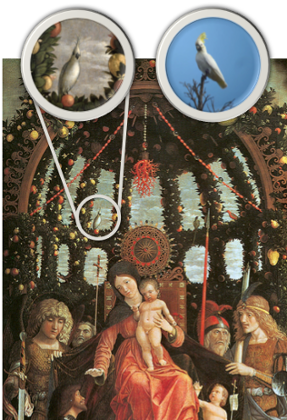Discovery of an animal more closely associated with Sydney than Venice is leading to a revision of early trading networks
With
its religious iconography and ornate throne, the 15th century
painting Madonna della Vittoria seems a typical Italian Renaissance
work – apart, that is, from the appearance of an Australasian
cockatoo in the background.
The
discovery of an animal more closely associated with suburban Sydney
than Venice is leading historians into a rethink of early trading
networks into Europe.
The
painting, completed by Andrea Mantegna in 1496 and now hanging in the
Louvre, clearly shows what appears to be a sulphur-crested cockatoo
perched above Mary, mother of Jesus.
It’s
unclear how Mantegna included a bird found in New Guinea and
Australia, given that trading routes to Europe were not clearly
established at the time.
Dr
Heather Dalton, a historian at the University of Melbourne, first
noticed the presence of the cockatoo 10 years ago and has been
working to confirm the bird’s identity for an analysis that has now
been published.
“I
was flicking through a book of paintings and thought ‘what is
that?’” she told Guardian Australia. “Other art historians
noted it was unusual but didn’t really explore it.
“Everyone
I’ve spoken to on this has said it absolutely is a sulphur-crested
cockatoo. It’s taken 10 years because I’ve wanted to be sure.”
Dalton
said Mantegna could have somehow obtained a picture of a cockatoo to
copy but there is good reason to believe he had a live bird.
“It’s
so realistic, looking straight ahead at you, relaxed” she said.
“This is unusual because later paintings of cockatoos, in the 17th
century, showed them sideways, with the crest erect, because they
were dead.
“These
cockatoos can live for more than 60 years so it could’ve lasted the
journey along the Silk Road routes, which would’ve taken years. It
would’ve been included as a symbol of luxury and to show the wealth
of the family which commissioned it.”
Dalton
said there is no other evidence of cockatoos in Europe at this time,
although other parrots were venerated at the time as being second
only to humans in the animal kingdom due to their ability to talk.
The
cockatoo could have been transported from Australia or eastern
Indonesia via China, altering what was previously known of trading
routes to Europe.
“We
know sea cucumbers were traded from the 17th century from Arnhem land
but not the area where these cockatoos were,” said Dalton. “The
Ming dynasty in China in the 1430s curtailed trade, which forced
traders marooned in Indonesia to look to trade into India and the
Middle East, which could then go onto Venice.
“This
could explain why the cockatoo got to Venice. Whether it’s from
Australia or Timor, it still challenges everything we know. I think
lots of people will be looking at these paintings more closely now.”
In
January, a 500-year-old prayer book belonging to a Portuguese nun,
which seems to depict a kangaroo, was
heralded as evidence that
the Dutch were not the first Europeans to arrive in Australia.

Nessun commento:
Posta un commento